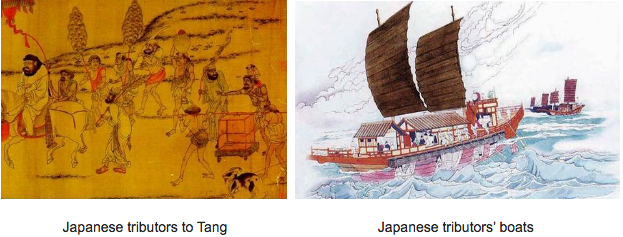Ancient History
During the Song Dynasty and Tang Dynasty, when China was still the regional hegemony in Asia, Japan sent students on a limited number of imperial embassies to China, to help establish its own footing as a sovereign nation in northeast Asia. After the fall of the Korean confederated kingdom of Baekje (with whom Japan was closely allied with) to combined Tang and Silla forces, Japan was forced to seek out the Chinese state on its own, which in those times was a treacherous undertaking, thus limiting the successes of Japanese overseas contacts during this time.

Important elements brought back from China included Buddhist teachings, Chinese customs and culture, bureaucracy, architecture and city planning. The Japanese kimono is very similar to the clothing of the Tang Dynasty, and many historians believe that the Japanese started wearing robes like what Tang royalty wore, eventually adapting the garb to match Japanese culture. The capital city of Kyoto was also planned according to Feng Shui elements from the Chinese capital of Chang’an. During the Heian period, Buddhism became one of the major religions, alongside Shinto.
The Prosperities of Maritime Trading 600-1600
Marine trades between China and Japan are well recorded. Tang imperialism posed a threat both to Japan, thus Japan had no choice but to directly trade with the Chinese dynasties. The ports of Ningbo and Hangzhou had the most direct trading links to Japan and Japanese residents conducted business there. Ningbo, therefore, was the destination of many Japanese embassies during this period. Direct trade with China was limited by the Tokugawa Shogunate after 1633, when Japan decided to close all direct links to the foreign world. Some trading was conducted by the Shimazu clan of Satsuma province through the Ryukyu Islands. Significant tradings between China and Japan did not resume until the twentieth century, well into the modern age.
Japanese Invasion of China (1937) Second Sino-Japanese War (1937-1945)
In 1937, the skirmish between Japanese and Chinese troops on the frontier led to what became known as the Marco Polo Bridge Incident. This fighting sparked a full-blown conflict, the Second Sino-Japanese War. Under the terms of the Sian Agreement, the Chinese Nationalist Party (KMT) and the Communist Party of China (CCP) now agreed to fight side by side against Japan. The CCP had been encouraged to negotiate with the KMT by Stalin, who regarded Japan as an increasing threat to his Far Eastern border, and began providing arms to China. China also received aid from western democracies, where the majority were strongly anti-Japanese. Britain, France and the US all sent aid (the latter including the famous ‘Flying Tigers’ fighter-pilot volunteers). Because of historic ties, China also received aid from Nazi Germany for a short period, until Hitler decided to make an alliance with Japan in 1938.
Although the Japanese quickly captured all key Chinese ports and industrial centers, including major cities like Nanking and Shanghai, CCP and KMT forces continued to resist. In the brutal conflict, both sides used ‘scorched earth’ tactics, resulting mass amount of massacres and atrocities. The most infamous massacre came after the fall of Nanking in December 1937, when Japanese troops slaughtered an estimated amount of 300,000 civilians and raped 80,000 women. Thousands of Chinese were killed in the indiscriminate bombing of cities by the Japanese air force. There were also savage reprisals carried out against Chinese peasants, in retaliation for attacks by partisans who waged a guerrilla war against the invader, ambushing supply columns and attacking isolated units. Warfare of this nature led, by the war’s end, to an estimated 10 to 20 million deaths of Chinese civilians.
By 1940, the war descended into stalemate. The Japanese seemed unable to force victory, nor the Chinese to evict the Japanese from territories they had conquered. But western intervention in the form of economic sanctions (most importantly oil) against Japan would transform the nature of the war. It was in response to these sanctions that Japan decided to attack America at Pearl Harbor, and so initiate World War II in the Far East.